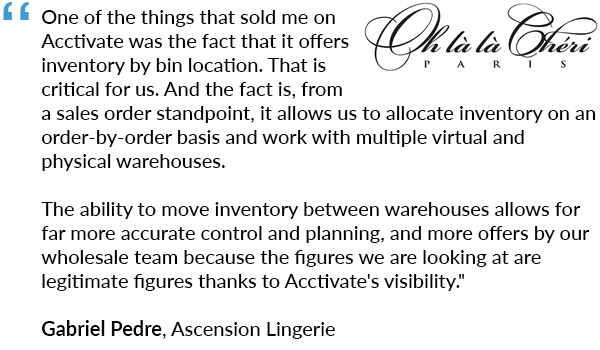What is a stock transfer?
Built For

Payton Viator, Senior Account Executive of Acctivate inventory software, discusses:
- The basics of inventory management
- What is a stock transfer in inventory management?
- Reasons for stock transfers
- The stock transfer process
- The role of technology in streamlining stock transfers
- Case Study: The impact of efficient management of stock transfers

Stock transfers are a subject we are frequently asked about. Stock transfers are part of the process of moving goods from one spot to another within a business, but there’s much more than meets the eye.
Managing inventory is more than just keeping shelves stocked. It’s about smartly navigating supply and demand, ensuring that products are not just available but available in the right place at the right time. This balancing act is crucial for keeping customers satisfied and business operations smooth.
Today, we’ll explore the nuts and bolts of stock transfers. We’ll look at why they’re a vital part of inventory management and how they’re efficiently executed, and share some tips and best practices along the way. So, let’s embark on this journey together and uncover the importance and impact of effective stock transfer management in today’s businesses.
Basics of Inventory Management
Before we explore the specifics of stock transfers, let’s set the stage with a quick primer on inventory management. Inventory management is the backbone of any product-based business. It’s the art and science of balancing what you have, need, and could do without.
What is inventory management?
Inventory management is tracking and controlling a company’s inventory, which involves overseeing the flow of items from manufacturers to warehouses and finally to points of sale.
The goal? To have the right products in the correct quantity, at the right time, and at the right cost.
Why is inventory management critical?
Effective inventory management reduces costs, improves cash flow, and boosts a business’s bottom line. Inventory management ensures there’s enough stock on hand to meet customer demands and avoid overstocking, which can tie up capital unnecessarily.
What are the critical components of inventory management?
- Inventory tracking: Monitoring stock levels and inventory movement.
- Demand forecasting: Predicting future customer demand to avoid stockouts or excess inventory.
- Inventory optimization: Balancing the right amount of inventory with demand, considering factors like lead times and market trends.
What are common challenges in inventory management?
Common inventory management issues include overstocking, stockouts, managing inventory in multiple locations, and keeping up with market changes and customer preferences.
Understanding these basics helps us appreciate why stock transfers are not just a logistical necessity but a strategic tool in inventory management. Stock transfers allow businesses to respond flexibly to changing demands and maintain the right balance of stock across different locations. With this groundwork laid, we’re ready to delve into the heart of stock transfers and their role in maintaining this delicate balance.
What is a Stock Transfer in Inventory Management?

Now that we have a foundational understanding of inventory management, let’s zoom in on stock transfers.
Stock transfer definition
A stock transfer involves moving inventory from one location to another within the same organization, including transfers between warehouses, stores, or different sections within the same facility.
Types of stock transfers
- Inter-warehouse stock transfers: Moving stock between different warehouse locations, often to balance inventory or meet regional demand.
- Intra-warehouse stock transfers: Shifting items within the same warehouse, perhaps from overstock areas to picking shelves.
- Cross-docking: Transferring goods directly from incoming to outgoing trucks or shipping areas, minimizing storage time.
Why stock transfers matter
Stock transfers are essential for:
- Maintaining inventory balance
- Reducing overstocks
- Avoiding stockouts
- Optimizing storage spacer
- Reducing holding costs
- Enabling businesses to be agile and responsive to market changes and customer demands.
Stock transfer considerations

- Accuracy: Ensuring that the right items in the correct quantities are transferred.
- Timing: Timing transfers to align with demand patterns and avoid disruptions.
- Costs: Balancing the costs involved in transferring stock against the benefits of having inventory optimally distributed.
Stock transfers are a vital cog in the machinery of inventory management. Stock transfers are not just about moving things around; they’re about intelligent movement that aligns with a company’s broader operational strategies. As we move forward, we’ll explore how these transfers are executed and the best practices to make them as efficient as possible.
Reasons for Stock Transfers
Stock transfers are strategic decisions made for a variety of reasons to help businesses optimize their inventory management and respond effectively to market demands.
- Balancing inventory levels: Transferring stock to balance inventory across different locations, avoiding overstock in one place and shortages in another.
- Meeting regional demand: Addressing variations in customer demand across different geographic locations, ensuring popular items are readily available where and when they are most needed.
- Seasonal adjustments: Moving items to meet seasonal fluctuations in demand, for example, sending winter gear to retail stores in colder regions as winter approaches.
- Reducing storage costs: Transferring excess inventory to locations with lower storage costs to minimize expenses associated with holding stock.
- Streamlining operations: Consolidating inventory in centralized locations for easier management, improving distribution and fulfillment processes efficiency.
- Supporting promotional activities: Stocking up locations in preparation for sales, events, or promotions, ensuring sufficient inventory is available to meet expected increases in demand.
- Responding to unexpected events: Adapting to sudden changes in market conditions or disruptions in supply chains.
Each of these reasons highlights the importance of stock transfers in keeping the inventory aligned with business goals and market dynamics.
The Stock Transfer Process
Understanding the mechanics of how stock transfers are executed is crucial. This section breaks down the typical steps involved, highlighting the precision and planning required to make these transfers smooth and effective.
- Planning and initiation of stock transfers: The process begins with identifying the need for a transfer, often based on inventory levels, demand forecasts, or sales data. Decisions about which items to transfer, in what quantities, and to which location are made.
- Preparation: Physical preparation of items for transfer, which can include picking, packing, and labeling to ensure items are ready for safe and efficient transport to other warehouses.
- Documentation: Creating documents like transfer orders, shipping labels, and customs or regulatory paperwork. Accurate documentation is vital for tracking and compliance purposes.
- Transportation (if required): Choosing the proper mode of transportation based on urgency, cost, distance, and item specifics.
- Receiving and verification: Upon arrival, items are checked and verified against transfer documents, crucial to ensure the accuracy and integrity of the inventory.
- Updating inventory records: Reflecting the transfer in inventory management systems to maintain real-time inventory accuracy, which involves adjusting stock levels at both the sending and receiving locations.
Technology can automate many aspects of the stock transfer process, from planning to record-keeping. Through this structured process, stock transfers become more than just a logistical task; they transform into a strategic operation that enhances inventory efficiency and business agility.
The Role of Technology in Streamlining Stock Transfers

Technology plays a key role in achieving accuracy and efficiency with stock transfers. Businesses can significantly streamline their stock transfer processes by integrating advanced tools like inventory management software and barcode technology.
Inventory management software
- Centralized inventory control: Consolidating inventory data across multiple locations into a single, accessible system makes tracking and managing stock transfers more efficient and reduces the likelihood of errors.
- Visibility across locations: Extensive visibility into inventory levels, including physical warehouses and virtual within a warehouse, enables businesses to manage and track their inventory with greater precision across the organization.
- Bin location specifics: Detailed insights into exactly where items are stored within a warehouse provide granularity crucial for efficient picking and stock transfers, as it reduces the time and effort required to locate items for movement.
- Real-time inventory tracking: Advanced inventory tracking capabilities allow businesses to monitor the status of stock transfers in real time.
- Detailed reporting: The software provides detailed reports and analytics, giving insights into transfer histories, efficiency, and areas for improvement.
Barcode technology
- Accuracy: Scanning barcodes during stock transfers ensures accurate data entry and tracking of items, reducing errors.
- Efficiency: Barcode scanning speeds up picking, packing, and verifying items for transfer.
Case Study: Ascension Lingerie’s Transformation with Acctivate and Managing Stock Transfers
Ascension Lingerie, a Miami-based high-fashion lingerie design house and manufacturer, offers a compelling story of how Acctivate transformed its inventory management and overall business operations.
Background
Gabriel Pedre, the Senior Director of Operations, juggled various responsibilities, from inventory management to overseeing key accounts. Initially, Ascension Lingerie used QuickBooks for financial and inventory needs, but they faced challenges in inventory and sales order management due to limited visibility and allocation issues.
The shift to Acctivate
Recognizing the limitations of QuickBooks, Ascension Lingerie conducted extensive research to find a more robust solution. Moving to Acctivate was a strategic step in the company’s infrastructure development to elevate the business to the next level.
Acctivate’s impact on stock transfers
With Acctivate, Ascension Lingerie experienced smoother inventory processes, better organization, and more accurate purchasing and order fulfillment. Their newfound visibility and control over inventory enabled them to make more informed offers, as they could rely on legitimate, up-to-date figures.
Gabriel Pedre specifically highlighted the importance of the bin location and stock transfer capabilities:
Call us at 817-870-1311





